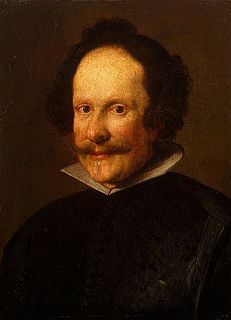
Claudio Coello was a Spanish Baroque painter. Coello is considered the last great Spanish painter of the 17th century.

Baldassare Aloisi, or Baldassare Galanino, was an Italian history and portrait painter and engraver. He was also known as Il Galanino.

Francesco Costanzo Cattaneo was an Italian painter of the Baroque period, born and mainly active in Ferrara. He is also known as Costanzo or Costanza Cattanio.

Bartolo di Fredi, also called Bartolo Battiloro, was an Italian painter, born in Siena, classified as a member of the Sienese School.
Padre Stefano Cassiani was an Italian painter of the Baroque.
Antonio Capulongo was an Italian painter of the late-Renaissance period.

Gabriele Cappellini was an Italian painter of the Renaissance. He was also called il Caligarino or il Calzolaretto, from his having first pursued that trade. He was born in Ferrara, and there trained under Dosso Dossi, he was active c. 1520. For the church of San Francesco, Ferrara he painted a St. Peter and St. James and for San Giovannino the principal altar-piece, representing The Virgin and Infant with several Saints.

Juan Antonio Bouzas was a Spanish painter of the Baroque period. He was born at Santiago de Compostela. He was a pupil of Luca Giordano at Madrid. The troubles occasioned by the war of the succession obliged him to withdraw himself from Madrid, and he returned to his native city. His principal works are in the churches at Santiago. In the cathedral is a picture of St. Paul and St. Andrew, and in the convent of the Dominicans are two altar-pieces by him. He painted easel pictures which bear a resemblance to those of his master.
Robert van Audenaerde or Ouden-Aerd (1663–1748) was a Flemish painter and engraver.

Jean-Victor Bertin was a French painter of historical landscapes, inspired by Italy and known for the minute detail of his classical style.

Johannes Brandenberg was a Swiss painter.

Gustave Brion (1824–1877) was a French painter and illustrator. He was born at Rothau in the department of Bas-Rhin on 24 October 1824. In 1841, in Strasbourg, he entered the studio of Gabriel Guérin, with whom he remained three years; he also received tuition from Andreas Friedrich, the sculptor; but he soon afterwards went to Paris, where his first work appeared at the Salon in 1847; it was entitled Interior of a Farm at Dambach. Six years later he gained a medal of the second class for his 'Schlitteurs de la Foret-Noire' and the Potato Harvest during an Inundation, the former of which was subsequently burned at Strassburg by the Prussians. His fame was further established by his Le Train de Bois sur le Rhin in 1855, and from that time his works continued to increase in public favour, and gained considerable praise and recompense for their author. Brion received numerous medals in 1853, 1863, 1867, 1868, &c., and the decoration of the Legion of Honour in 1863. He died in Paris 3 November 1877.

Bernardino Cervi or Cerva was an Italian painter of the Baroque period.
Giovanni Angelo Criscuolo was an Italian painter active mainly in Naples.

Stefano Dall' Arzere or Stefano Dell'Arzere was an Italian painter of the second half of the 16th century.

Nicolaas Liemaker, or de Liemaker, de Liemaeckere, surnamed Roose, or Nicolaes Roose a Flemish historical painter, was born at Ghent in 1601. He was the son of Jacob De Liemaker, a painter upon glass, and is said by Descamps to have been a pupil of Markus Geeraerts the younger, but as the latter joined his father in London in 1580, it is most likely that he studied under Otto van Veen at Antwerp. He attained high rank in his profession, and in 1625 returned to Ghent, where he died in 1646. The Museum of Ghent and the churches of that city and of other towns of Flanders possess a great number of his works. His best picture is the 'Consecration of St. Nicholas, Bishop of Myra,' which is above the high altar of the church of St. Nicholas at Ghent.

Blas de Prado, or Del Prado, was a Spanish painter, who was born in the vicinity of Toledo, about 1540, and was a scholar of Alonso Berruguete. There are some of his works in the chapel of St. Blas at Toledo, but they are much injured by time and the dampness of the situation. At Madrid there are also some pictures by this artist, particularly an altar-piece in the church of San Pedro, representing the 'Descent from the Cross,' which is evidently the work of a great master. In the early part of his life Prado was invited to visit the court of the Emperor of Morocco, to paint a portrait of his daughter, and returned to Spain amply rewarded for his labour. Whilst at Fez he painted the portraits of the Princesses of the Harem. He died at Madrid about 1600.
Jan van Rijn or Jean de Reyn was born at Dunkirk about the year 1610, and went when he was young to Antwerp, where he became a student of van Dyck. Such was his progress under that master, that he was invited to accompany him to England, where he continued to assist him until the death of his illustrious instructor. He afterwards established himself in his native town, where he painted several admirable pictures for the churches, and was much employed as a portrait painter. His principal works for the churches at Dunkirk were the 'Death of the four Royal Martyrs,' for the church of St. Eloi; and the 'Baptism of Totila,' for the church of the English convent.

Martin Fréminet was a French painter.
Luzio Dolci or Lucio Dolce was a late 16th-century Italian painter active in Castel Durante in the Province of Pesaro and Urbino in the Region of the Marche.














